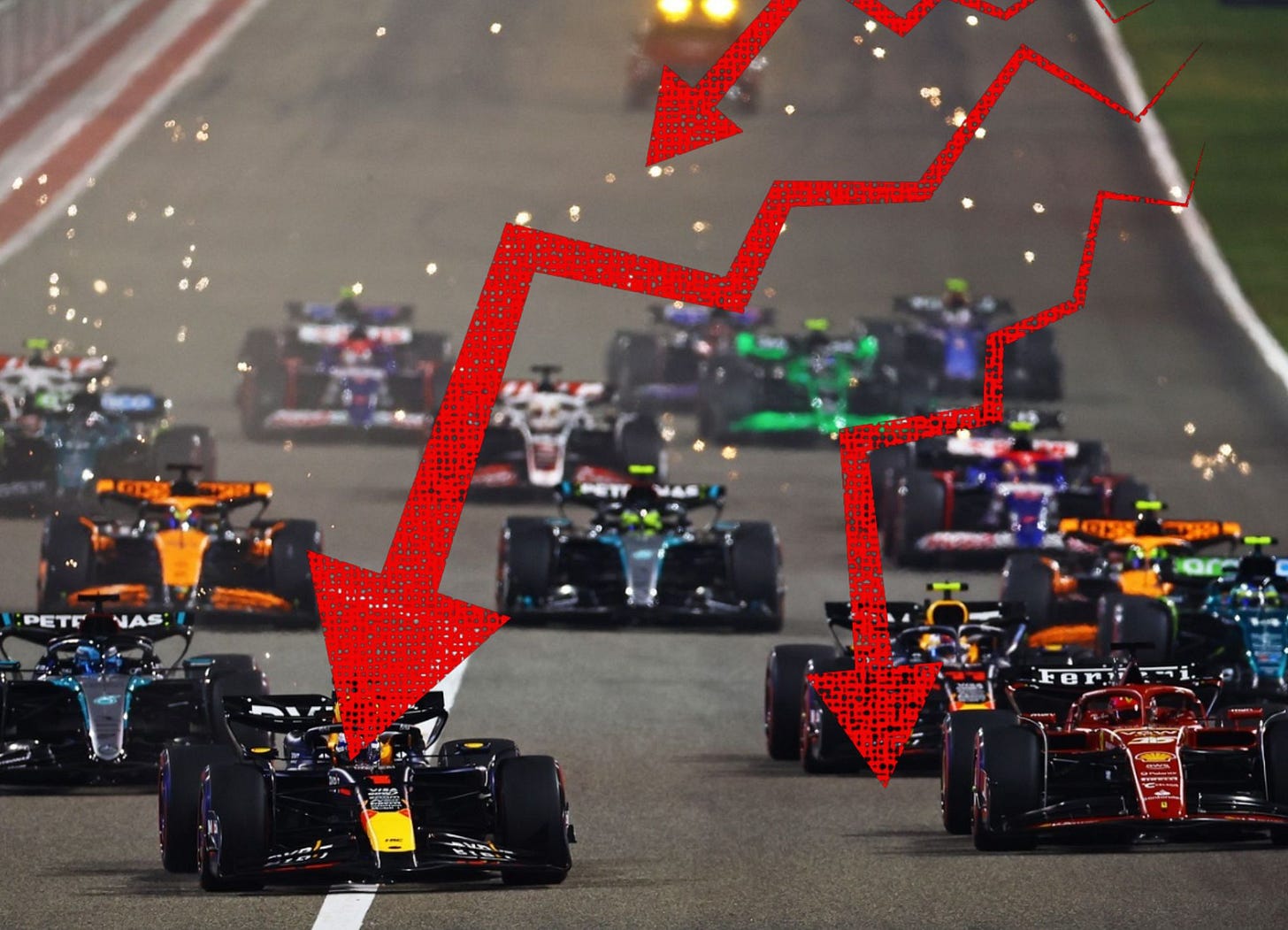Who's to Blame?
After the Bahrain Grand Prix, fans demanded answers for the "imploding" sport and weren't shy to point fingers
Ahead of Saturday’s Bahrain Grand Prix, Road & Track published an article titled “Max Verstappen is Killing Formula 1.”
Social media echoed the sentiment as Verstappen crossed the checkered flag first, arguing that the Red Bull driver finishing down the ranking could be the best thing for the sport.
Instead of bowing to spectator desires, Verstappen started and finished the race in first place. Fans on X (formerly Twitter) were quick to throw away the new season altogether.
“This was the most boring F1 season opener. This sport is actually gone,” one user posted. “Sorry, they actually want us to watch 23 more races of this?” another one asked.
The race result felt routine, and like a dumpster fire of unreliability for the rest of the grid, with Sergio “Checo” Perez dragging behind his teammate by 22.457 seconds and Carlos Sainz falling short by an additional 2.653 seconds. The three, however, were the lucky few.
The rest of the F1 grid faced everything from a broken race seat on Lewis Hamilton’s end to a front left brake issue that left Charles Leclerc deeming the Ferrari “dangerous” to pull around the circuit’s tricky corners. Williams’ steering wheel screens glitched and displayed a “car too hot” warning, Valtteri Bottas had a 52.44-second pit stop (an eternity compared to McLaren’s record-breaking 1.80-second one last year) and to top it all off, Alpine’s car seemed to have more faults than assets.
What began to look like a tidier race pace across the 10 teams in testing and free practice was swiftly abandoned. The gulf between drivers stretched a similar width compared to last year. Fernando Alonso crossed the finish line in ninth yet was still 74.887 seconds behind the race leader. His teammate, Lance Stroll, spread the gap even further as he trailed 93.216 seconds behind. Logan Sargeant’s Williams was lapped twice.
After Nico Hulkenberg’s Haas tapped Lance Stroll’s Aston Martin from behind and the successive waves of reliability issues hit the grid, it’s surprising that all 20 drivers finished the season-opening race — the first time in F1’s 75-year history.
Despite a podium for Ferrari’s Sainz, a sixth-place jump for Kick Sauber’s Zhou Guanyu and consistent positions for both McLarens, Red Bull’s performance on-track and scandals off-track overshadowed other drivers’ achievements.
The 2024 Drivers’ World Champion may as well have already been crowned, was deemed the consensus. Fueled by their boredom, fans were quick to point accusatory fingers: First, at Verstappen. At the other 19 drivers. Then at Liberty Media. And, finally, at each other.
Complaints began to filter in before the top three even sprayed champagne from the podium.
After winning 21 out of 22 races last year, Red Bull’s extended dominance seemed inevitable and fans weren’t shy about sharing their deflating interest. One side argued that F1 was on the precipice of folding in on itself. The other side of the camp insisted that winning streaks have plagued the sport previously.
Fans aren’t wrong, there have been waves of dominance throughout F1’s history, but Verstappen’s performance is unprecedented. They also aren’t wrong about the effect: ABC reported a 25 percent drop in viewership at the 2023 Miami Grand Prix compared to the previous year’s record-breaking 2.6 million TV viewers. Viewership fell 10 percent last season and, as Red Bull surges forward, it will likely continue to dip.
Liberty Media’s three-year media rights deal with ESPN, however, will keep raking in cash through 2025.
As the chants of “boring” began to die down on Saturday, the three-time World Champion’s talent wasn’t the gasoline fueling this social media war. Instead, the outrage landed on Liberty Media. The media giant aimed to make the sport more entertaining, and therefore unpredictable, for American audiences when it bought F1 in 2017. Sprint race additions crowded the calendar and a growing list of celebrity VIPs lined the paddock as the sport swelled off-track. Drive to Survive increased this slow march of shifting attention when it launched in 2019. An influx of off-track investment, marketing campaigns and driver spotlights effectively distracted from a predictable race outcome in the short term.
Now, whispers of misconduct — whether the allegations against Christian Horner now leading to rumors of Verstappen’s departure or the investigation into the president of the sport’s ruling body for an alleged attempt at race fixing — are continuing to veer eyes to the track’s periphery.
But amid all that this refocusing accomplished (higher profits and a temporary boost in viewership), it also split racing fans into two distinct groups that transcended team allegiance: Those who were here before Drive to Survive and those who were here after. A crack split the parties into what Road & Track deemed “real fans” versus those who are stopping by for a glance at the glitz and glam.
Both blame each other for tainting the sport.
“Formula 1 is so entertaining when there’s no racing,” is poised to be the anthem of the next 10 months. And as for who is to blame? Fans may find many guilty while F1 has few to brand as the culprit more than its own off-track attention-seeking activities.





